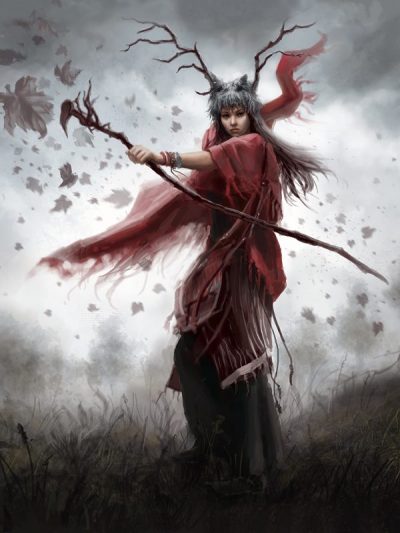Wilderness travel is one of the things I always wanted to include as a major element of my campaigns but the rules as written in either B/X or LotFP require too much on the spot calculation and conversion of movement speeds in different terrains that I just can’t handle at the table with my ADD when the players are talking about what they are going to do next at the same time. Adding the attack bonus to a d20 roll and subtracting hit points I can manage, but doing divisions and fractions while paying attention to conversations just ends up with me getting brain locked. All my homebrew systems and my choice of LotFP as the system I am using have been done as means to compensate for my impairment in this regard. Making game mechanics more accessible for people with neural impairments is something I’ve never seen anything written about and might be worth dedicating a post or two to in the future.
Last year I already tried my hand at coming up with a simpler and faster solution, but it’s still based on the underlying assumptions of a hexcrawl with way more precision and granularity than I need for Sword & Sorcery adventures. But a great idea for something much better comes once again from Angry-sensei, who just has some kind of gift for making methods that are practical to use instead of being best suited to programm a computer with. There are two big things of beauty in his proposal. The first one is that it doesn’t require a map with precise measurements or any degree of accuracy. In addition to being quite a lot of work for GMs, the current design standard for maps is basically satelite photography which is something that wouldn’t be available to people within most fantasy world but in my own experience also create a sense of the world being fully explored and tamed. Which is the complete opposite you’d want in a mythic bronze age Sword & Sorcery world. Tolkien’s hand drawn map for The Lord of the Rings is what I consider the ideal form of fantasy map. It’s a tool for navigation that provides an idea of the general layout of the lands but also has a level of abstraction that inspires the viewer to wonder what marvelous places might be hidden in all those blank spots that noboy alive has ever set foot in. The second great thing about it is that it works without any calculations and requires only looking up a single number in a simple table. This post is an adaptation of this concept to the rules of LotFP with some tables for actual use in play.
Travel Times and Distances
When a party makes an overland journey, the first step is deciding on the path they want to foollow from their starting point to their destination. The GM then makes a quick rough measurement on the map (which can be as sketchy as you want) or makes a judgement call how long this path is in miles. At the start of each day, the GM decides which type of terrain the party will mostly be travelling through on that day. Knowing the encumbrance rating of the slowest character or pack animal in the party, the GM simply looks up on the following table how many miles the party covers on that day.
| Terrain |
Unencumbered |
Lightly Encumbered |
Heavily Encumbered |
| Road |
24 miles |
18 miles |
12 miles |
| Heath/Moor/Plains |
16 miles |
12 miles |
8 miles |
| Desert/Forest/Hills |
12 miles |
9 miles |
6 miles |
| Jungle/Mountains/Swamp |
8 miles |
6 miles |
4 miles |
Soldiers throughout history have been marching at about 3 miles per hour on good roads, so with 8 hours of marching you get 24 miles per day. While those soldiers would have been encumbered by gear, they also wouldn’t be travelling through untamed wilderness, so I think this table makes a decent enough approximation of plausible travel speeds.
Mounts
Contrary to movies and books, horses do not cover greater distances in a day than a human can. While they can run much faster at short distances, humans (and dogs) are the world’s best endurance runners and can keep on walking with much less need for rest than other animals. The distances covered by humans and horses are about the same. The big important difference is that horses can carry a lot more weight than humans and are much less slowed down by the same loads. Riding and pack animals should have the same movement rates as humanoids but with double or tripple the carrying capacity of an average person for calculating encumbrance,
Water Travel
17 different types of ship with different sailing and rowing speeds, 5 classes of quality, and 9 degrees of weather conditions is a bit more than needed when dealing with travel at this level of abstraction. I reduced it all down to this simple table.
| Type |
Favorable Conditions |
Average Conditions |
Unfavorable Conditions |
| Canoe |
24 miles |
18 miles |
12 miles |
| River Boat |
80 miles |
60 miles |
40 miles |
| Sailing Ship, Slow |
120 miles |
90 miles |
60 miles |
| Sailing Ship, Fast |
160 miles |
120 miles |
80 miles |
I’ve done some researching of my own about the speeds of (admitedly modern) sailing ships and the numbers in the Expert rules and LotFP seem to be way off. These numbers for distance travelled in a day are much closer to what you could actually expect from real ships. For canoes the distance is given fr 8 hours, as for marching, but for the others the distance is for a span of 24 hours since they are powered by wind and people can take turns with steering while the others rest. For canoes and river boats favorable and unfavorable conditions means going downstream or upstream. Average conditions would be on lakes. For sailing ships these apply to the weather and the wind in particular. Whether they are favorable or unfavorable can be determined with a simple roll of a d6, with a roll of a 1 or a 6 indicating that less or more distance has been covered that day. On the seas travel distances can vary greatly, but this is a good enough approximation for a game.
Wilderness Encounters
Another suggestion by Angry that I also take pretty much as is is rolling for wilderness encounters by rolling a number of d6 bases on how how much monster traffic is present in an area the party is travelling through on a given day. For every die that rolls a 1 there will be an encounter sometime during the day. At what time during the day and in what terrains these encounters will take place is up to the GM to decide. I got curious and calculated the odds for wilderness encounters with this method:
| #d6 |
Threat Level |
No Encounters |
1 Encounter |
2 Encounters |
3 Encounters |
| 1 |
Settled or desolate |
83% |
17% |
– |
– |
| 2 |
Wilderness |
69% |
28% |
3% |
– |
| 3 |
Hostile Wilderness |
58% |
35% |
7% |
1% |
| 4 |
Hostile Patrols |
48% |
39% |
12% |
2% |
They are not actually as high as I expected. Not having any encounters at all still remains the most likely outcome by a good margin and even at higher threat levels the chance to have multiple encountes in a single day is very low. As Angry explains it in a much more elaborate way, this is actually a pretty nice addition to the regular wilderness encounter rules. It raises the number of factors players have to consider when picking a route to three: “How long would we be at risk at encuntering monsters in that area?”, “How dangerous are the monsters we might encounter in that area?”, and now also “How many monsters are in that area?” Go through the swamp that is choking with giant spiders or risk the shortcut over the mountains where almost all creatures have been killed by a dragon?
I very much encourage using the rules for foraging and starvation. Carrying a large amount of rations means the party wil be slowed down but make consistent progress each day. Not packing enough rations for the whole journey (to make room for treasure for example) means that the party is travelling lighter and at a faster speed. While finding enough food in the wilderness is relatively easy with a trained specialist or a scout, the time it takes is highly unpredictable and can cause the party to actually make even less progress in a day. It’s a nice layer of added uncertainty that the players can consider in their planning for wilderness journeys.
Since more than a single encounter per day is very unlikely even in the more crowded regions, the encounter tables should be stocked in a way that there is real danger for the party. If the players have no reason to expect the possibility of a character dying or the party getting captured then they also have no incentive to hurry up, making the whole exercise of wilderness encounters moot.
Encounter Distances
If an encounter happens, use this table to determine the distance as which surprise rolls are being made by both sides.
| Terrain |
Distance |
| Forest/Jungle |
2d6 x 10 yards |
| Desert/Hills/Swamp |
3d6 x 10 yards |
| Heath/Moor/Mountains/Plains |
4d6 x 10 yards |
| Lake/Sea |
4d6 x 10 yards |
When travelling on rivers, use the row for the surrounding terrain. The distance for encounters on sea or lakes are for encounters with monsters. Ships can be seen from much larger distances.


